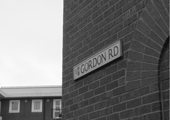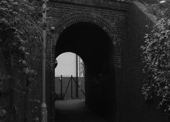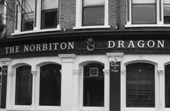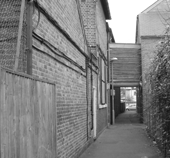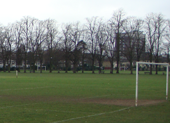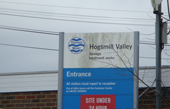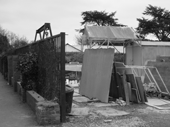Circumperambulation
of
Norbiton: Ideal City
the First part
The logic of Norbiton’s streets has nothing to do with its circumference. Their grain is governed by the line of the railway, the routes into Kingston and Wimbledon. If you try to walk its perimeter you are forcing that grain, committing a minor spatial infraction.
The same can be said of the streets of its interior: they do not lead to other places within Norbiton, but originate and terminate outside it. Their business is not with Norbiton, but across it.
Five citizens gathered, therefore, on a Wednesday morning in March with the intention of walking the circumference of Norbiton, and of carving Norbiton: Ideal City out of the recalcitrant space of Accidental Norbiton.
![]()
Norbiton Station
The station is the Great Gate of Norbiton. It stands like a quest barrier on the northern rim of the ward.
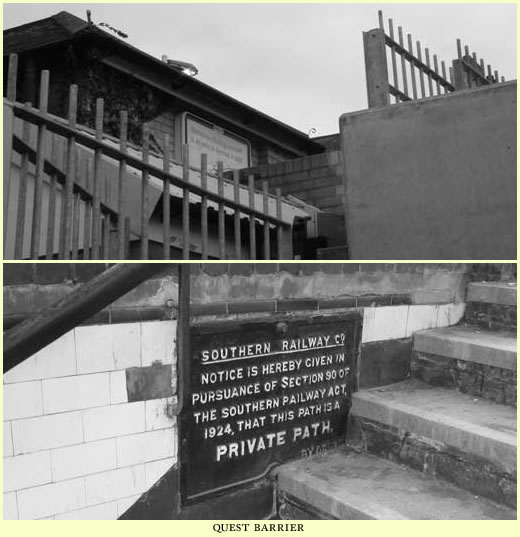
Its main entrance is on the Coombe Road looking away from Norbiton; there is an exit also on Norbiton Avenue, leading into the fabled city. Its two platforms, running trains into Wimbledon and Waterloo and out to Kingston and beyond (the trains in fact loop back around the park and return to Waterloo by other routes) are connected by a subway. The borders of Norbiton proper follow the railway line: duck under by the subway and you’re in. Platform 1 is in Canbury; platform 2 is in Norbiton.
On platform 1 there is a modest coffee shed, run by Neville. Neville is fortyish, stout, frets over plastic cups and small change, makes a really very acceptable latté. The inside of the hut is decorated with paintings in which we recognise the hand of his children, vague infantile studies in medieval perspective, where daddy’s head is very big and the rest of the stuff of the world is jinked in anyhow wherever it will fit.
Clarke has a cappuccino sweetened with four little bags of artificial sweetener; Hunter Sidney has a cup of tea; I have a latté; Emmet Lloyd has what we’re having; and Kelley has nothing.
I had not expected Kelley to be there. He isn’t really part of the project. Neither is Emmet Lloyd, but Emmet Lloyd may as well be. Emmet Lloyd is wealthy by inheritance and heir to failure in all its forms; but Kelley is a man of genuine accomplishment. He has his dogs with him:  a pair of aristocratic loping greyhounds who pay no attention to any of us for the duration of the walk barring the occasional cock of an ear when Kelley speaks to them; they seem set on a mission of their own, moving through the space of their own contiguous city.
a pair of aristocratic loping greyhounds who pay no attention to any of us for the duration of the walk barring the occasional cock of an ear when Kelley speaks to them; they seem set on a mission of their own, moving through the space of their own contiguous city.
I’m growing restless because Neville’s platform is more Canbury than Norbiton, so we drink up our frothy milk, thank Neville, and pass out on to the Coombe Road.
![]()
station — gordon road — lovekyn chapel — fairfield rec.
Leaving the station on the Coombe Hill side, then, we work our way up to the northern boundary along Station Road and then Gordon Road. We will be walking anti-clockwise.
Gordon Road skirts the railway line and overlooks the back of the telephone exchange on Birkenhead Avenue. Just past the Big Yellow Storage Unit, and before rounding the dogleg at Wickes the builders’ merchant, a concealed path (Orchard Way) leads under the railway arch past Orchard Cottages and out of Norbiton. The path runs directly to the door of the Norbiton and Dragon, coiled, as it were, in the doorway to Norbiton. We hesitate over the prospect of a pint, then double back to Gordon Road, and briefly join the A307 circulatory system as far as London Road, passing, on the way, one of the entrances to Tiffin School. We join the London road at the Lovekyn Chapel.
The Lovekyn Chapel is, I suppose, the oldest building in Norbiton. My brother used to teach the piano one day a week at Kingston Grammar School (which lies, for the most part, beyond the ward) which at the time used the Lovekyn Chapel as practice rooms. 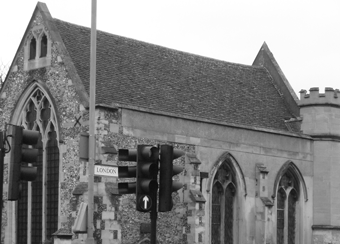 The chapel stands for the most part unregarded at the junction of two busy roads, and while it would be pleasant to reflect upon the 15th century chapel as an oasis of music and sanity isolated in a turbid river of madness, it is worth recalling that piano lessons, for both teacher and pupil and anyone who happens to overhear, are in themselves a chaos of half-scales, repeated dinning fragments, gear-grinding incompetence and the occasional moment of confusing beauty. My brother, shuttered in a pullulating asylum of proto-music, might have found some relief stepping into the open space of the light-controlled junction, joining the graceful flow of automobiles and pedestrians, participating in the clear patterns of daily life.
The chapel stands for the most part unregarded at the junction of two busy roads, and while it would be pleasant to reflect upon the 15th century chapel as an oasis of music and sanity isolated in a turbid river of madness, it is worth recalling that piano lessons, for both teacher and pupil and anyone who happens to overhear, are in themselves a chaos of half-scales, repeated dinning fragments, gear-grinding incompetence and the occasional moment of confusing beauty. My brother, shuttered in a pullulating asylum of proto-music, might have found some relief stepping into the open space of the light-controlled junction, joining the graceful flow of automobiles and pedestrians, participating in the clear patterns of daily life.
We cross the London Road in search of the narrow passage way leading between, on one side Kingston Grammar School (which Edward Gibbon briefly attended), and the gardens of the houses of Minerva Street on the other, towards the Fairfield Recreation Grounds. The Grounds lie outside Norbiton. They have perhaps four measured and whited football pitches, which are silent, it being Wednesday morning.
Clarke finds a half-soft ball in the bushes by the fence, and blunders out on to the Rec., thumping the ball in front of him; in a minute or two Clarke and Kelley and Lloyd are having a bit of a kick around, Lloyd in one of the gaping goals and Clarke and Kelley vying for mastery of the ball; neither is much good, although Kelley might have been once; Clarke is long-limbed and ungainly, physically ponderous but an encumbrance for Kelley who contents himself with appearing not to care too much. Clarke does a lot of swearing, and a lot of standing with his hands on his knees, but in the end interposes his bulk sufficiently well to have more of the ball.
Hunter Sidney and I watch over the railings. I ask him about Kelley, about why Kelley is here. Hunter Sidney never says very much – it is too painful for him, I suppose – but he says now that Kelley likes to get out of the house, does not like to go into work, so here he is; he has a queer history of some sort – Clarke thinks he is a warlord, a gun-runner and IRA warlord, that he has in the past blown men to perdition; so he might be looking for solace in fretful inaction. But Clarke has a taste for drama, revolution. More and more as your life nears completion, Sidney notes, you hesitate in the mid-spaces between action and action; you sit and wait in the garden of your soul. It need not be anything more than that.
Clarke works some sort of clutsy but effective move on Kelley and toe-punts the ball past an incompetent Lloyd – who I realise now did not once touch the ball – and we are off again.
![]()
Fairfield Rec — Villiers Road — Lower Marsh Lane — California Road
From the junction with Fairfield South, we head down Villiers Road, which marks the Western boundary of Norbiton and, at the point where it meets the Hogsmill river, the extreme South West of Norbiton.
Villiers Road crosses the Hogsmill over a flat bridge. On the near side, a path leads alongside the river for a hundred yards before a fence halts further progress. We are left with the alternatives of either wading down the river or scouting out to the South of Norbiton.  The river itself is flat, placid, ankle deep. There are plastic bags caught in the weeds and bobbing plastic bottles, and the buzzing of river insects. Its banks are probably well known to children and teenagers, who are accustomed to getting down low to see the terrain, getting into the crawlspace of the world. But this is a little more than we bargained for and we continue, without discussion, down Villiers Road to Lower Marsh Lane, up the far side of the Hogsmill valley towards Surbiton.
The river itself is flat, placid, ankle deep. There are plastic bags caught in the weeds and bobbing plastic bottles, and the buzzing of river insects. Its banks are probably well known to children and teenagers, who are accustomed to getting down low to see the terrain, getting into the crawlspace of the world. But this is a little more than we bargained for and we continue, without discussion, down Villiers Road to Lower Marsh Lane, up the far side of the Hogsmill valley towards Surbiton.
Lower Marsh Lane has the feel of the country about it, or at least the feel of those fractal edges of London in its more ungoverned, less compacted use of space. Civ Clarke says that in Rome on an outlying road like this you’d find grubby boys herding goats or piling up washing machines on the hot scrubland by their gypsy encampments. But this is not scrubland; it was no doubt once marshy, the sludgy beds of the Hogsmill spreading itself out in choked oxbows and stagnant meanders. Now it is the sewage works, and the walker is surrounded by invisible wisps of light high gases. The security guards who patrol, we are informed, twenty-four hours a day behind the wire fences might from time to time be led astray in the small hours by the wills-o’-the-wisp, the sewage sprites, dancing over the rich soaked land, the big squelch of river valley and sewage seeping across the land. Perhaps they are sucked down, smiling delirious oracle smiles, to roam the silent dark lost forests for eternity.
We’ll have to come back here by night. By day, a weekday morning, there are a few people going about their business. The Surbiton side of the lane is lined by tatterdemalion stone cutters and sellers of granites and marbles for monuments – some of them, as I learn later, part of Kelley’s spidery business (Kelley says nothing about it as we pass them); they are spread out along the road with strips of stone leaning this way and that, old men with leather hands whitened by the stone dust stooping about among their inventory; and then the cemetery, Surbiton cemetery, which, as we peer over the brambly railings, seems only half full, as though the Last Trumpet were still many drowsy centuries off; the corpses have hung up signs, gone off somewhere. A notice on the gate says that someone is carrying out an audit of the gravestones and monuments for safety, but nothing much seems to be happening; perhaps the notice has been there for years, the progenitor of this audit now lying in some other graveyard, forgotten, and the dead here, after a momentary hiatus of activity, left to themselves again, a hidden corner of municipal informality, a pleasant enough place to spend eternity, or some of it at any rate.
After the cemetery Lower Marsh Lane thins to a path, still straggling between the sewage works and some old pumping stations with their abandoned winching tackle and wonky Thames Water signs. We pass Berrylands station, whose steepling platforms are ranged against Norbiton station as one castle might defy another across a rich champaign, re-bridge the Hogsmill and cross back into Norbiton along the Kingston Road at the junction with California Road.
![]()
California Road — Kingston Road allotments
At this point a disagreement flares up. Clarke can’t be bothered to continue. If we want to complete the circumnavigation we’ll have to turn up Dickerage Lane, cross the railway and wind back towards the station along Orme Road and Gloucester Road; but this would take us outside Norbiton again, we would complete our circumnavigation in the manner of a besieging general looking for weaknesses. Or we could keep inside the railway line, following Douglas Road and Porchester Road and Homersham Road as far as Norbiton Avenue; but we wanted to throw a girdle around the earth, not shave off the round earth's imagined corners. This is Clarke’s line of argument – there will be no point completing it unless we walk along the railway line.
While I disagree, I’m not going to put up a fight, but Hunter Sidney says we should do things properly. We need to make a good start. We've come here for a reason and we should see it through.
Clarke counters that for a project or series of projects dedicated to the Failed Life, cocking up our first venture would be not only appropriate but proleptic. Hunter Sidney tries to remind him that the Failed Life is not about failure, but it is a difficult argument to make and he is running short of breath.
Kelley, who has not, seemingly, been paying much attention but has stood a couple of yards off smoking a cigarette, now says
"Doing things properly is right; but part of doing things properly is knowing when to ditch them, or which bits of them to ditch. This fucking walk, for a start.”
He has a point. Building is as much about dereliction as construction. Letting the form of the project emerge. I’m suddenly convinced that what the project needs is a meta-CircumPerambulation. A futile abortion of a foundation ritual. We should head up to the allotments and have a drink.
Hunter Sidney gives up the fight and we walk up Kingston Road. As we go, we discuss the building of cities. Or rather, Kelley gives us a lecture on the building of cities. He says this is no way to build a city, this voodoo traipsing in circles, this mordant musing over dead stones. (And he is right: we have learnt nothing, established nothing, defined nothing). Nor, contrary to what he implied earlier, do you build cities by dereliction. No. You build them one brick at a time, and someone, somewhere, has to feel the heft of every single last solitary brick.
He explains that when he built his football stand (the Palladian North End - see Architectural for more detail) in the 1980s, there were weeks and months with no work going on at all. And he would go over every day and just pick stuff up and shuffle it around, thinking he would be smoothing the way for when they got back to it, how the bricks should be there and the trucks could pull in here and so on. And then he took to laying courses of bricks himself.
When you are putting together something of that size, he says, and you are reduced to doing it a brick at a time, by yourself, in your off-hours, and every time you raise your eyes to wipe the sweat away you see only how much there is left to do, stretching off to the horizon, piles of bricks and stacked bags of cement and who knows what else, rusted scaffolding and heaps of rubble and hardcore, like some vast jigsaw and you cannot even remember what the picture was of. Well, he says, my whole memory of that time is of me labouring in futility in the rain, trying not to think about how it was impossible to do all this on my own. I don’t know about your Ideal Cities, but that’s how real ones are built right enough – one bitter fucking brick at a time.
And then, as though taking pity on my useless pottering state, he offers me a job – a little work in his garden. He has a large garden and no time to work in it, he says. He has been thinking of getting a professional gardener, but he doesn’t want anything done really except the grass cutting and the beds weeded, perhaps some bushes cut back; so if I want the work, there it is. I say yes, why not, and we agree that twice a week I will come around at my convenience in the afternoons and do whatever it occurs to me to do.
Later on, when Kelley has gone off with his dogs and we are left in the allotments with a last tin, Clarke says to me, it isn’t him. It isn’t him that cares about the garden. It’s his wife.


